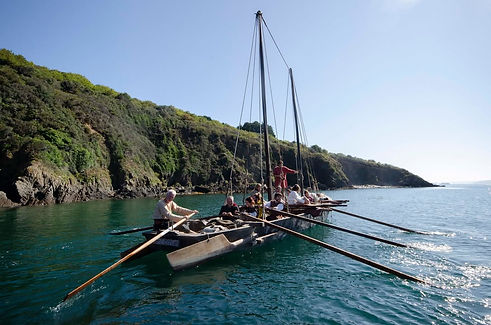
Nos bateaux
10th-century reconstruction

Brioc
The Brioc is our first vessel.
Brioc is a sailing hypothesis of a curragh from the Early Middle Ages.
Built in 1999, its creation aimed to highlight the maritime origins of the city of Saint-Brieuc, through the myth of the Breton founding saints, and particularly Saint Brieuc, or Brioc in Breton.
Its construction is unique, as it is not based on any wreck plan, but on the study of iconography, hagiographic texts, and in the tradition of Tim Severin’s Saint Brendan.
5th–10th century reconstruction
Sant Efflam
Sant Efflam is a sailing hypothesis of a curragh from the Early Middle Ages, built in 1997 thanks to the research of Tim Severin, archaeological work, and hagiographic texts.
Its rigging is based on 10th-century sources, and it particularly illustrates the Latin influences on Breton navigation of that period. This leather-hulled vessel is typical of those used by Celtic evangelist monks and navigators.

Reconstruction of the 12th–16th Centuries

Joutsen
Joutsen is a faering typical of the 13th–14th century.
This type of boat was used for traditional Scandinavian fishing.
Faerings have often been attributed to the Vikings, but historical sources show that they already existed in Antiquity.
Historical research has shown that Joutsen is typical of the 13th and 14th centuries because its rudder is at the stern.
Indeed, on the oldest faerings, it is placed on the side.
14th–16th century reconstruction
Aileach II
Aileach II is our Birlinn construction project, another sailing hypothesis, this time from the Late Middle Ages.
Although no Birlinn wrecks have survived, the precision of the sources (such as the Drogheda boat, Scottish carved stones, Aber Wrac’h I, Magor Pill wreck, and certain French illuminations) makes this type of vessel highly plausible.
Emblematic of the Scottish Hebrides, this type of ship also resonates with an Irish wreck, another Welsh one, and yet another Breton one, offering us a new opportunity to highlight interceltic culture and solidarity.
This project intersects the work of archaeologist Alexandra Grille and students from the IUT MINM of Lorient (Naval and Maritime Industry), and flourishes thanks to the expertise of shipwrights Bleuenn Chorlay and Benoit Cayla, as well as the commitment of our members.
Construction is scheduled for the end of 2026.

18th–19th century reconstruction

Droit de cité
Droit de Cité is a flagship boat, known as a “Bantry Yole,” based on the 1796 Bantry Yole model. Built in 1999, it allows us to evoke the technical splendor of the golden age of sailing, both through its military aspect and the skill required to handle such a fast vessel.
The crew of Droit de Cité is fully dressed according to the 1805 regulations, reflecting the missions of the French Navy during the First Empire. Yoles of this type were used as transport boats and navigated along coasts inaccessible to warships.
Late 18th century reconstruction
Leier Eusa
Leier Eusa is a gaff-rigged cutter, also called a marking or pilot barge, with a design typical of the 18th century. Built in 1991 based on the plans of an “Ouessant Ship” from the book Souvenirs de marines by Admiral Paris, it allows us to evoke the history of the pilot station on the island of Ushant.
In the 18th and 19th centuries, marking navigation involved trading from one registered port to another, but ships armed for this purpose often engaged in smuggling. Leier Eusa, thanks to its versatility and its dimensions ideal for navigating the challenging coasts of Finistère and beyond, highlights this hidden chapter of Breton maritime heritage.

Support and come on board !
So, if you are tempted by the adventure, don't hesitate! Support us with what you can, or come on board Brioc!
It is dear to our hearts that as many as possible can share into this adventure, which is why many different projects have also seen the light of day in parallel to TroBrioc. We have a documentary project following the whole expedition, an artistic project aiming to have an exhibition at the end of the adventures, and more importantly a continuous stream of videos documenting the project to the masses.
Still in this idea of having a vast amount of people contributing, we are planning on loading Brioc with goods representative of the medieval maritime trade. We will thus be taking on wine, pottery and goods made by our craftspeople. If you are interested in them, or you wish to have your goods transported by Brioc, get in touch with us!



